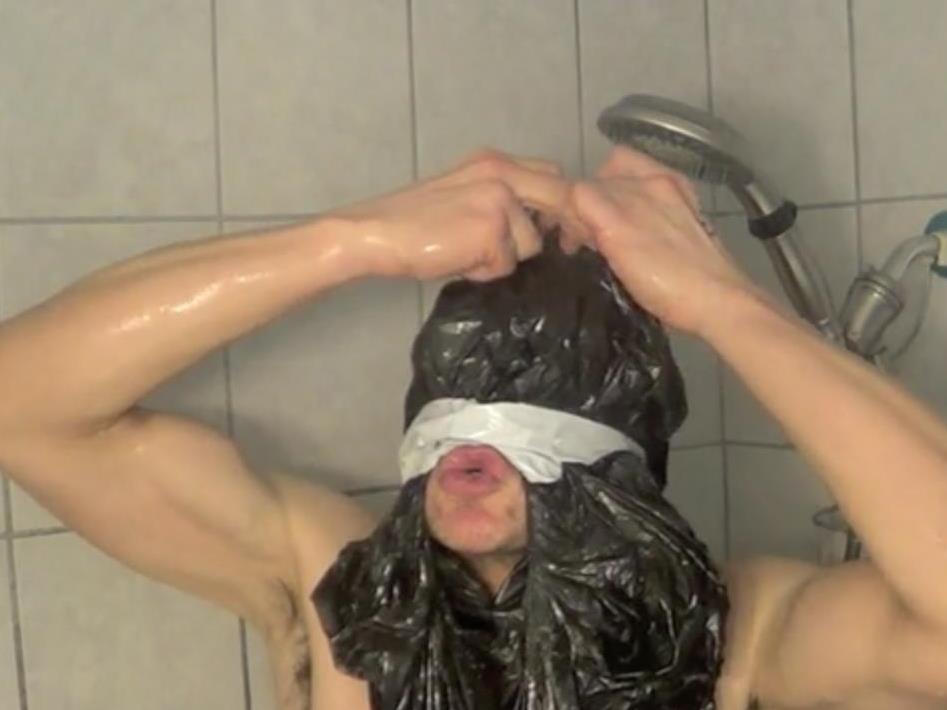Image: Patrick Rees, Attempting to Simulate the Experience of Singing Happy Birthday in the Shower with a Bag Over my Head, 2014, single channel digital video 6:59min.
PP/VT is an ambitious exhibition charting the trajectory of performance and video from the 70s to today. It is a form that has been reinvigorated through the advancements in technology but more importantly by the challenging talents of contemporary artists. However, larger questions are posed in this exhibition regarding the philosophy of live performance today and its counterpart, video. Since its groundbreaking inception in the 1970s, performance and video art has played a significant part in testing the physical and cognitive limits of an artist, documenting social and political action as well as tracing/marking real time. It is a challenging and demanding medium that can explore the grotesque and sublime in a matter of minutes. This exhibition considers a ‘renaissance’ of the practice and charts its influences in contemporary art today. Set across two spaces and including live performance spattered across the length of the exhibit, as well as a one-day symposium, PP/VT is an overwhelming undertaking that encourages multiple visits.
The relationship between performance and video has changed the traditional roles of artist and audience, enabling the artist to be creator and/or director with the viewer as an active participant. Part of the medium’s development is the transforming role of the artist both within their work and outside of their work. Today a number of approaches that cross different mediums can be undertaken and led by the artist.
Lauren Brincat is one such artist whose practice encompasses a number of mediums including live performance, video, sculpture and installation. Her 2012 work Mexican Standoff has taken different forms, each iteration bringing new meaning and conversation to the piece. Here we see the role of the artist as director; orchestrating a scenario, filmed from various angles and matched with a sound track adding dimension to the experience. A group of women (including Brincat) travel through the city’s chaotic traffic on horseback towards the steps of the National Museum. They defiantly stand in a line in front of a statue/relic of a man also on top of a horse watching over the institution. This visceral and slow paced action rebelliously counteracts the environment of Mexico City; a town riddled with crime, chaos and danger. This stoic stance from a group of women in front of this historical ‘protector’ is a powerful reminder of the sidelining of women as well as the greater social structures of the city.
Patrick Rees’ Attempting to Simulate the Experience of Singing Happy Birthday in the Shower with a Bag Over my Head is a peculiar encounter which forms a larger body of work investigating the artist’s ongoing research into process, performance and functionality. The artist tests his body and senses in a simple but enduring domestic action. The DIY/slapstick nature of his work is heightened by an awareness of chance; an opportunity to convert the mundane into the surreal. Humour can play an important role in performance art; breaking down the barrier between the artist and viewer, awakening new ideas or trivializing archaic ones. Rees’ second exhibition work Attempting to Simulate the Experience of Singing Happy Birthday Underwater Followed by a Little Bit of Star Spangled Banner takes on a similar vein but with the addition of an underwater camera; inverting the view of the performance from the artist’s to the spectator’s. Each breath, bubble and slippery noise from the bathtub is intensified with each shot; the shallowness of the water is sometimes unclear and the muffled noise of a birthday tune sang underwater is almost ethereal. Rees’ performance is funny, honest and alarming. Rees is a part of a number of performance artists who work in real time, challenging their threshold directly in front of the camera. The ordinariness of today can now be considered an important testing ground for experimental performance.
Sound has played a pivotal role in video art in recent years. It is a medium that can evoke emotion, heighten senses and convey a story. Video art has certainly gained more popularity over the years by the shared pursuits of artists and musicians.
Jess Olivieri & Hayley Forward’s Harlequins Vs Visitors is one such example; here we see the Sydney Chamber Choir participate within the work directed by the artists. Filmed on the grounds of the Harlequins rugby team, the ‘visitors’ are pitted against the (absent) locals in a match. The visitors perform a series of vocal training exercises led by a conductor and are filmed from various angles focusing on the public space and their inhabitance of it. It is a striking work both in its starkness and rich musical composition.
PP/VT questions if the core values of performance art still resonate in contemporary ‘performance video’ asking the viewer to compare the experiences of filmed and live performances throughout the duration of the show. Certainly we can see today an increase in platforms available to the viewer, but, has this come at the cost of the experience? The spectator’s role has developed alongside the history of performance art and PP/VT broadly debates these changes through a series of provoking and immersive works.
Rating: 4 out of 5 stars
Performance Presence/Video Time
AEAF & Central School of Art
Lion Arts Centre, North Tce
Adelaide South Australia
31 March – 16 May 2015





